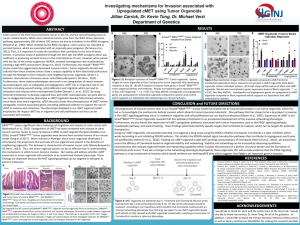Carrick, Jillian: Investigating Mechanisms for Invasion Associated with Upregulated cMET Using Tumor Organoids
Title: Investigating Mechanisms for Invasion Associated with Upregulated cMET Using Tumor Organoids
Name: Jillian Carrick
Major: Genetics
School affiliation: School of Arts and Sciences
Programs: Human Genetics Institute of New Jersey MacMillan Cancer Genetics Summer Undergraduate Research Fellowship (HGI-SURF)
Other contributors: Michael Verzi, Kevin Tong
Abstract: Colon cancer is the third most prominent cancer in the US, and the second leading cause of cancer-related deaths. While most colorectal tumors arise from the WNT-driven adenoma pathway, approximately 10% of these CRC tumors are due to mutations in the BRAF oncogene (Powell et al., 1992). When initiated by the BRAF oncogene, colon cancers are classified as serrated tumors, which are associated with an especially poor prognosis (De Sousa et al., 2013). Thus, it is important to study the conditions that contribute to the arise of these tumors. In previous research published through the Verzi Lab, the BRAF oncogene alone was inefficient in producing serrated tumors in the small intestine of mice. However, when paired with the loss of the tumor suppressor SMAD4, serrated tumorigenesis was accelerated by creating a high WNT environment (Tong et al. 2017). Furthermore, the Smad4f/f BRAFV600E/+ mouse model also aggressively developed invasive tumors. Tumor organoids derived and cultured from these invasive tumors show a unique capability to form directional protrusions through the Matrigel to form networks with neighboring tumor organoids, which is a behavior characteristic of invasive cancer cells (Sibony-Benyamini, Gil-Henn., 2012). Furthermore, these invasive phenotypes also result in an upregulation of cancer invasion-associated genes such as ivadapodia and angiogenesis. cMET has an important role in cell functions including wound healing, cell proliferation and migration which can lead to metastasis and invasion when overexpressed (Safaie Qamsari, E. et al., 2017). By using lentiviral transfection to develop organoid lines with cMET overexpression, we were able to see an exaggerated invasive phenotype as cMET organoids develop fully formed networks much faster than mock organoids. qPCR data also shows that overexpression of cMET further upregulates invasion-associated genes, providing additional evidence to support the role of cMET in invasion and metastasis. The phenotype displayed in our cMET organoid model emphasizes the impact cMET has in migration and cell proliferation and thus can be associated with invasion.
